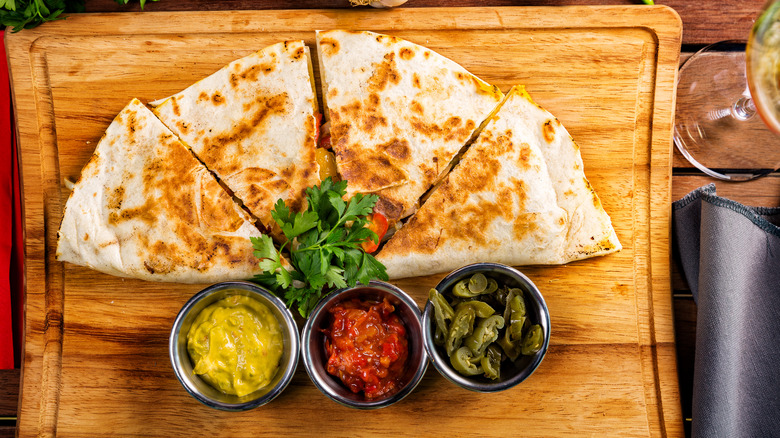Why Placement Of The Cheese Matters When Making Quesadillas
If you've ever made a quesadilla and found your fillings falling out the sides, you may have placed your cheese incorrectly. David Davidov, recipe developer and creator of The Cooking Foodie, tells us it's the glue that holds your dish together and you should make liberal use of it for the best end product.
"If cheese is placed directly against the tortilla, it creates a "seal" that crisps and caramelizes beautifully while helping the tortilla stick to the filling," says Davidov. He recommends "... a thin layer of cheese both underneath and on top of the filling, that way you get structure, gooey texture, and flavor in every bite." When the cheese melts, it should blanket every last portion of your filling, binding it together as well as to the tortilla. Rachael Ray even toasts the inside of her quesadilla before assembling it, guaranteeing the cheese melts evenly and quickly so you don't lose any ingredients when you flip it.
Whether you use slices, shreds, or smears of cheese, be sure they cover the entire inside of the tortilla from end to end. It's better to lose some to the pan rather than use too little and compromise your food's structure. Feel free to even mix some cheese into the filling itself, giving it more weight, flavor, and integrity. Provided you pick something that's high in moisture, young, and highly meltable, even slicing your quesadilla shouldn't present any problems.
Best types of cheese for quesadillas
While cooking tricks like making your quesadilla in a waffle iron can force even the driest cheeses to melt well and adhere all your ingredients together, it's still better to pick a cheese that melts well regardless of how you cook it. These give you the rich flavor, creamy texture, and perfect adhesive properties that define a great quesadilla.
"Mild melting cheeses like Oaxaca, Chihuahua, or Monterey Jack perform best against the tortilla for that signature stretchy melt," David Davidov says. Oaxaca is a great semi-hard cheese because you can grate it or slice it just like mozzarella, blanketing your tortilla perfectly. Chihuahua is a bit softer and melts beautifully, creating a mild, buttery blanket that's perfect for mixing into fillings. Monterey Jack is a solid middle ground, offering a bit of a sharper taste than either but melting quite well. You can even use cottage cheese in your quesadilla filling for a protein-packed twist.
"Inside, I like to mix in a bit of sharper cheese (like aged cheddar or cotija) to add depth and a bit of tang that cuts through the richness," Davidov finishes. If you use these, be sure to pair them with a softer cheese that can provide a bit more adhesion. While these may not melt quite as well, their flavors complement everything from grilled peppers to barbacoa, acting more like a seasoning than something that will hold your tortilla together. Cotija, in particular, is especially great for mixing into fillings because it's often sold in a powdery form, meaning it'll disperse through your other ingredients quite well.


